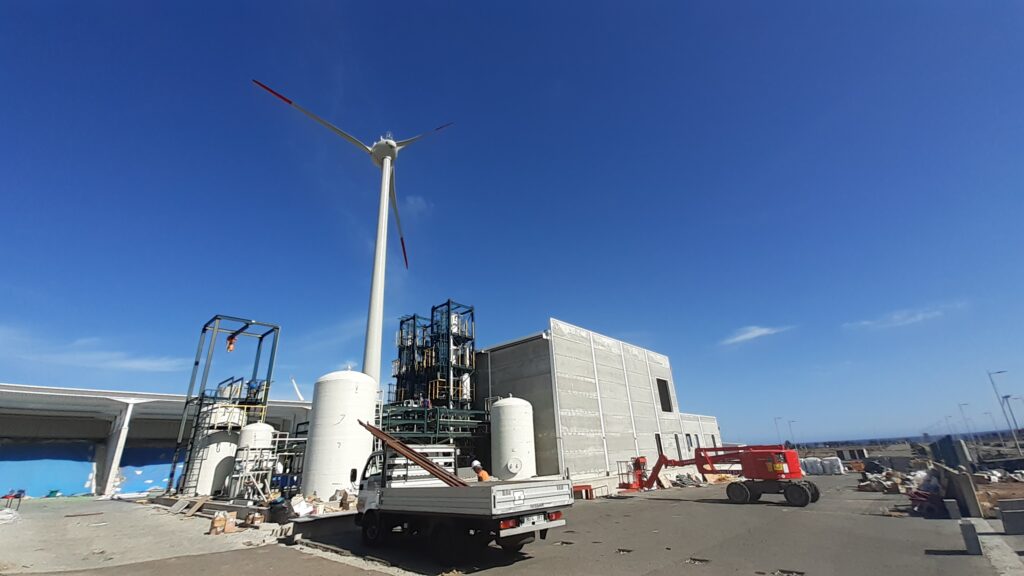The use of renewable energies, such as wind power, has become increasingly important in the pursuit of sustainable and cost-effective solutions that reduce dependence on fossil fuels. In many regions, the use of clean technologies is driven both by the need to alleviate climate change and by the economic benefits that they bring to businesses and communities.
One example is in the installation of wind turbines, a means of harnessing the wind as a source of energy and thereby reducing electricity consumption from the grid and minimising a company’s carbon footprint. Here we explain how this type of installation works, its advantages, challenges and applications, with a practical example in one of our industrial plants.
The process of wind power generation
Wind energy is generated by systems that convert the kinetic energy of wind into electricity. The wind rotates the blades of the installation, which are connected to a rotor. The movement of the rotor generates electricity that is then used directly by the industrial installation. The system consists of several key stages:
- Wind capture: the wind turbine blades, positioned high up to take better advantage of the air currents, capture the wind energy and transfer it to the rotor.
- Energy conversion: The rotor is connected to a generator that converts mechanical energy into electricity.
- Internal energy distribution: The electricity generated is consumed directly in the electrolysis plant.
- Monitoring and control: The system is equipped with advanced software that allows for real-time monitoring and control of energy production, ensuring that the generation is adjusted to the needs of the plant and that efficiency is maximised at all times.
The advantages of wind turbines
The use of wind turbines offers several advantages, both from an economic and an energy point of view. Some of these advantages include:
- Reduced energy costs: By generating its own electricity, the plant significantly reduces its dependence on the grid and the costs associated with the purchase of energy.
- Sustainability and emissions reduction: As a clean energy source, the installation contributes to reducing CO₂ emissions and the overall carbon footprint of the plant.
- Energy independence: Self-consumption allows the plant to be more self-sufficient in terms of energy, reducing its vulnerability to possible fluctuations in the price of electricity.
- Efficient and safe technology: Modern wind generation systems, such as the one we installed, include advanced safety and efficiency mechanisms, guaranteeing optimal and safe operation during their useful life.
Challenges and the future of wind energy
Despite its advantages, wind energy faces certain challenges. One of the main challenges is wind variability, which can affect the constancy of electricity generation. To address this problem, energy storage systems are being developed to store the surplus electricity generated on windy days for use when conditions are not favourable.
Another area of evolution is in technological efficiency. New generations of wind turbines are designed to be larger and stronger, capturing more energy but with less wear and tear.
Artificial intelligence and machine learning are also being integrated into monitoring systems to adjust operation in real time, thereby improving the stability and efficiency of the generation.
Other uses of wind energy
Beyond industrial self consumption, wind energy is playing a crucial role in large-scale electricity generation through the use of wind farms, both onshore and offshore. Offshore wind, in particular, is gaining momentum in countries with long coastlines, where wind turbines can take advantage of stronger and more stable winds. This type of energy has enormous potential to meet the growing demand for electricity in a sustainable way.
Welysis Las Palmas: A case study
At our plant, located in the Arinaga Industrial Estate in Gran Canaria, we have installed a 900 kW wind turbine designed specifically for self-consumption. The wind turbine has a 55 metre high tower and a 44 metre diameter rotor, dimensions that were carefully selected to maximise wind capture. Its location was strategic too, as it takes into account the predominant wind direction in the area while avoiding interference with other nearby installations.
With an estimated annual generation capacity of around 2.5 GWh, this wind turbine is expected to cover up to 40% of the plant’s annual energy needs. This will not only significantly reduce energy costs, but will also strengthen the plant’s independence from electricity price fluctuations. Furthermore, the system will enable an estimated saving of up to 1,025 tonnes of CO₂ per year.
The turbine also includes an advanced remote control system to monitor and manage energy production in real time, thereby ensuring its safe and efficient operation.

Social and environmental impact
Wind energy not only benefits companies, but also local communities. In areas where wind farms are installed, economic development can be seen through job creation in the construction and maintenance of wind turbines. In addition, land use compensation agreements generate additional income for rural communities.
From an environmental perspective, wind energy is one of the cleanest forms of electricity generation. Its use minimises greenhouse gas emissions and has a much lower impact in terms of water consumption and land use compared to other energy sources.
In short, wind energy is a key pillar in the transition to a more sustainable energy model. Its ability to generate clean and cost-effective electricity makes it a viable option for industrial and large-scale applications. With technological advances and new developments in storage and control, wind energy is poised to play an increasingly important role in reducing dependence on fossil fuels and combating climate change, whilst contributing to a greener and more self-sufficient future.





